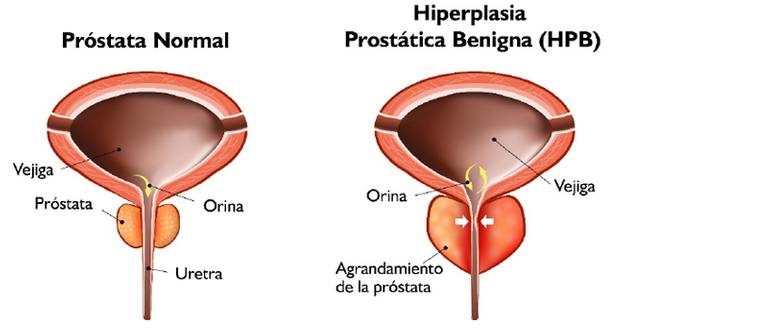[ESP/ENG] Crecimiento prostático benigno Vs. Cáncer de próstata / Benign prostatic growth Vs. prostate cancer


En esta ocasión les hablaré sobre un tema bastante temido por nosotros los hombres, pero, sobre todo, el tabú sobre uno de los métodos diagnósticos utilizados en nuestra área, especialmente en el área de urología: el tacto rectal.

A cordial greeting to the entire community, a pleasure to greet you, here is your server: @galejandrovv.
On this occasion I will talk to you about a subject that is quite feared by us men, but above all, the taboo about one of the diagnostic methods used in our area, especially in the area of urology: digital rectal examination (DRE).

¿QUÉ ES EL CRECIMIENTO PROSTÁTICO BENIGNO?
¿WHAT IS BENIGN PROSTATE GROWTH?

Fuente / Source

¿CUÁLES SON LOS SIGNOS Y SÍNTOMAS?
¿WHAT ARE THE SIGNS AND SYMPTOMS?
Los síntomas obstructivos son los más frecuentes y los que aparecen con mayor rapidez, pero, los irritativos son los que más interfieren en la vida cotidiana del individuo.
La presencia y/o combinación de algunos de estos síntomas, debe ser alarmante y requiere atención médica lo más pronto posible.
The obstructive symptoms are the most frequent and those that appear more quickly, but the irritative ones are the ones that most interfere in the daily life of the individual.
The presence and/or combination of any of these symptoms should be alarming and require medical attention as soon as possible.

¿CUÁLES SON LOS FACTORES DE RIESGO?
¿WHICH ARE THE RISK FACTORS?

¿CÓMO DIAGNOSTICARLA?
¿HOW TO DIAGNOSE IT?
Además, existen otros métodos diagnósticos para dicha patología, entre ellos tenemos: antígeno prostático (PSA), tacto rectal, biopsia, resonancia magnética, etc.
La OMS recomienda que todo hombre al llegar a los 40 años, debe hacerse anualmente un chequeo de la próstata, esto para detectar de manera temprana algún cambio anatómico de la misma, y, prevenir alguna complicación.
Dentro de los métodos diagnósticos se encuentra el temido tacto rectal, muchos hombres le huyen a ésto por diferentes razones, la más frecuente es el machismo. Es muy cierto que para nosotros los hombres es algo bastante complicado el tema, pero, cuando de salud se trata, no debería ser un problema. Además, existe la relación Médico-Paciente, la cual es íntima, privada y personalizada... el médico tratante debe respetar el pudor del paciente y explicarle absolutamente todo lo que hará.
In addition, there are other diagnostic methods for this pathology, among them we have: prostate antigen (PSA), digital rectal examination, biopsy, magnetic resonance imaging, etc.
The WHO recommends that every man, upon reaching 40 years of age, should have an annual prostate check-up, in order to detect any anatomical change in it early, and prevent any complications.
Among the diagnostic methods is the dreaded digital rectal examination, many men flee from this for different reasons, the most frequent being machismo. It is very true that for us men the issue is quite complicated, but when it comes to health, it should not be a problem. In addition, there is the Doctor-Patient relationship, which is intimate, private and personalized... the treating doctor must respect the patient's modesty and explain absolutely everything he will do.

¿QUÉ DETERMINA LA DIFERENCIA ENTRE LA HPB Y EL CÁNCER DE PRÓSTATA?
¿WHAT DETERMINES THE DIFFERENCE BETWEEN BPH AND PROSTATE CANCER?
Existe el antígeno próstatico (PSA), el cual es una proteína sintetizada por las células de la próstata, éste parámetro tiene ciertos valores que nos pueden hacer sospechar de que hay algo afectando la producción del mismo, y que, pudiera ser algo altamente sospechoso de malignidad, pero, por sí solo no determina la presencia de células cancerígenas.
Los valores normales de PSA van de 0-4 ng/mL, valores por encima de eso pueden hacernos sospechar de diferentes patologías como: HPB, prostatitis, cáncer de próstata. El aumento anual progresivo del PSA de 0.75 ng/mL/año es altamente sospechoso de la presencia de cáncer de próstata, y, valores por encima de 10 ng/mL casi siempre lo confirman.
Pero, el ÚNICO método diagnóstico que va a confirmar la presencia o no de cáncer de próstata es una BIOPSIA PROSTÁTICA, valores elevados de PSA por sí solos no confirman el diagnostico de la patología, dichos valores deben estar respaldados por una biopsia para confirmar el hallazgo.
There is the prostate antigen (PSA), which is a protein synthesized by prostate cells, this parameter has certain values that can make us suspect that there is something affecting its production, and that it could be something highly suspicious of malignancy, but by itself does not determine the presence of cancer cells.
Normal PSA values range from 0-4 ng/mL, values above that can make us suspect different pathologies such as: BPH, prostatitis, prostate cancer. The progressive annual increase in PSA of 0.75 ng/mL/year is highly suspicious for the presence of prostate cancer, and values above 10 ng/mL almost always confirm it.
But, the ONLY diagnostic method that will confirm the presence or not of prostate cancer is a PROSTATIC BIOPSY, elevated PSA values by themselves do not confirm the diagnosis of the pathology, these values must be supported by a biopsy to confirm the finding .

¿CUÁL ES EL TRATAMIENTO DE LA HPB?
¿WHAT IS THE TREATMENT OF BPH?
Existen fármacos que pueden ser utilizados, como por ejemplo: antiandrogénicos, bloqueadores adrenérgicos, entre otros.
El tratamiento final, ya sería el tratamiento quirúrgico, que se propone cuando ya la HPB se hace muy crónica, limita la vida cotidiana del paciente y/o aumenta el riesgo de aparición de cáncer de próstata.
There are drugs that can be used, such as: antiandrogenics, adrenergic blockers, among others.
The final treatment would be surgical treatment, which is proposed when BPH becomes very chronic, limits the patient's daily life and/or increases the risk of developing prostate cancer.


Fuente / Source


 |  |  |  |
 |  |  |  |
Texto traducido en XTranslate
Separadores creados en Gravit Designer
Vectores descargados de Flaticon
Banner's creados en Canva
Translated text with the extension XTranslate
Separators created in Gravit Designer
Vectors downloaded from Flaticon
Banner's created in Canva

PRIMUM NON NOCERE


Electronic-terrorism, voice to skull and neuro monitoring on Hive and Steem. You can ignore this, but your going to wish you didnt soon. This is happening whether you believe it or not. https://ecency.com/fyrstikken/@fairandbalanced/i-am-the-only-motherfucker-on-the-internet-pointing-to-a-direct-source-for-voice-to-skull-electronic-terrorism
https://twitter.com/gablejandrovv/status/1490391137303117825
The rewards earned on this comment will go directly to the person sharing the post on Twitter as long as they are registered with @poshtoken. Sign up at https://hiveposh.com.